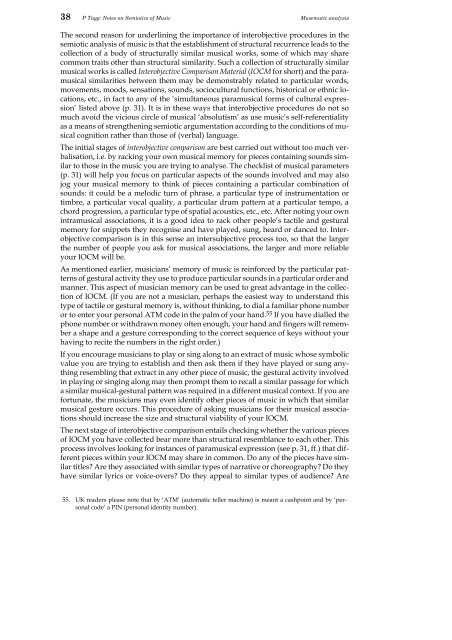Introductory notes to the Semiotics of Music - Philip Tagg's home page
Introductory notes to the Semiotics of Music - Philip Tagg's home page
Introductory notes to the Semiotics of Music - Philip Tagg's home page
Create successful ePaper yourself
Turn your PDF publications into a flip-book with our unique Google optimized e-Paper software.
38 P Tagg: Notes on <strong>Semiotics</strong> <strong>of</strong> <strong>Music</strong> Musematic analysis<br />
The second reason for underlining <strong>the</strong> importance <strong>of</strong> interobjective procedures in <strong>the</strong><br />
semiotic analysis <strong>of</strong> music is that <strong>the</strong> establishment <strong>of</strong> structural recurrence leads <strong>to</strong> <strong>the</strong><br />
collection <strong>of</strong> a body <strong>of</strong> structurally similar musical works, some <strong>of</strong> which may share<br />
common traits o<strong>the</strong>r than structural similarity. Such a collection <strong>of</strong> structurally similar<br />
musical works is called Interobjective Comparison Material (IOCM for short) and <strong>the</strong> paramusical<br />
similarities between <strong>the</strong>m may be demonstrably related <strong>to</strong> particular words,<br />
movements, moods, sensations, sounds, sociocultural functions, his<strong>to</strong>rical or ethnic locations,<br />
etc., in fact <strong>to</strong> any <strong>of</strong> <strong>the</strong> ‘simultaneous paramusical forms <strong>of</strong> cultural expression’<br />
listed above (p. 31). It is in <strong>the</strong>se ways that interobjective procedures do not so<br />
much avoid <strong>the</strong> vicious circle <strong>of</strong> musical ‘absolutism’ as use music’s self-referentiality<br />
as a means <strong>of</strong> streng<strong>the</strong>ning semiotic argumentation according <strong>to</strong> <strong>the</strong> conditions <strong>of</strong> musical<br />
cognition ra<strong>the</strong>r than those <strong>of</strong> (verbal) language.<br />
The initial stages <strong>of</strong> interobjective comparison are best carried out without <strong>to</strong>o much verbalisation,<br />
i.e. by racking your own musical memory for pieces containing sounds similar<br />
<strong>to</strong> those in <strong>the</strong> music you are trying <strong>to</strong> analyse. The checklist <strong>of</strong> musical parameters<br />
(p. 31) will help you focus on particular aspects <strong>of</strong> <strong>the</strong> sounds involved and may also<br />
jog your musical memory <strong>to</strong> think <strong>of</strong> pieces containing a particular combination <strong>of</strong><br />
sounds: it could be a melodic turn <strong>of</strong> phrase, a particular type <strong>of</strong> instrumentation or<br />
timbre, a particular vocal quality, a particular drum pattern at a particular tempo, a<br />
chord progression, a particular type <strong>of</strong> spatial acoustics, etc., etc. After noting your own<br />
intramusical associations, it is a good idea <strong>to</strong> rack o<strong>the</strong>r people’s tactile and gestural<br />
memory for snippets <strong>the</strong>y recognise and have played, sung, heard or danced <strong>to</strong>. Interobjective<br />
comparison is in this sense an intersubjective process <strong>to</strong>o, so that <strong>the</strong> larger<br />
<strong>the</strong> number <strong>of</strong> people you ask for musical associations, <strong>the</strong> larger and more reliable<br />
your IOCM will be.<br />
As mentioned earlier, musicians’ memory <strong>of</strong> music is reinforced by <strong>the</strong> particular patterns<br />
<strong>of</strong> gestural activity <strong>the</strong>y use <strong>to</strong> produce particular sounds in a particular order and<br />
manner. This aspect <strong>of</strong> musician memory can be used <strong>to</strong> great advantage in <strong>the</strong> collection<br />
<strong>of</strong> IOCM. (If you are not a musician, perhaps <strong>the</strong> easiest way <strong>to</strong> understand this<br />
type <strong>of</strong> tactile or gestural memory is, without thinking, <strong>to</strong> dial a familiar phone number<br />
or <strong>to</strong> enter your personal ATM code in <strong>the</strong> palm <strong>of</strong> your hand. 55 If you have dialled <strong>the</strong><br />
phone number or withdrawn money <strong>of</strong>ten enough, your hand and fingers will remember<br />
a shape and a gesture corresponding <strong>to</strong> <strong>the</strong> correct sequence <strong>of</strong> keys without your<br />
having <strong>to</strong> recite <strong>the</strong> numbers in <strong>the</strong> right order.)<br />
If you encourage musicians <strong>to</strong> play or sing along <strong>to</strong> an extract <strong>of</strong> music whose symbolic<br />
value you are trying <strong>to</strong> establish and <strong>the</strong>n ask <strong>the</strong>m if <strong>the</strong>y have played or sung anything<br />
resembling that extract in any o<strong>the</strong>r piece <strong>of</strong> music, <strong>the</strong> gestural activity involved<br />
in playing or singing along may <strong>the</strong>n prompt <strong>the</strong>m <strong>to</strong> recall a similar passage for which<br />
a similar musical-gestural pattern was required in a different musical context. If you are<br />
fortunate, <strong>the</strong> musicians may even identify o<strong>the</strong>r pieces <strong>of</strong> music in which that similar<br />
musical gesture occurs. This procedure <strong>of</strong> asking musicians for <strong>the</strong>ir musical associations<br />
should increase <strong>the</strong> size and structural viability <strong>of</strong> your IOCM.<br />
The next stage <strong>of</strong> interobjective comparison entails checking whe<strong>the</strong>r <strong>the</strong> various pieces<br />
<strong>of</strong> IOCM you have collected bear more than structural resemblance <strong>to</strong> each o<strong>the</strong>r. This<br />
process involves looking for instances <strong>of</strong> paramusical expression (see p. 31, ff.) that different<br />
pieces within your IOCM may share in common. Do any <strong>of</strong> <strong>the</strong> pieces have similar<br />
titles? Are <strong>the</strong>y associated with similar types <strong>of</strong> narrative or choreography? Do <strong>the</strong>y<br />
have similar lyrics or voice-overs? Do <strong>the</strong>y appeal <strong>to</strong> similar types <strong>of</strong> audience? Are<br />
55. UK readers please note that by ‘ATM’ (au<strong>to</strong>matic teller machine) is meant a cashpoint and by ‘personal<br />
code’ a PIN (personal identity number).














